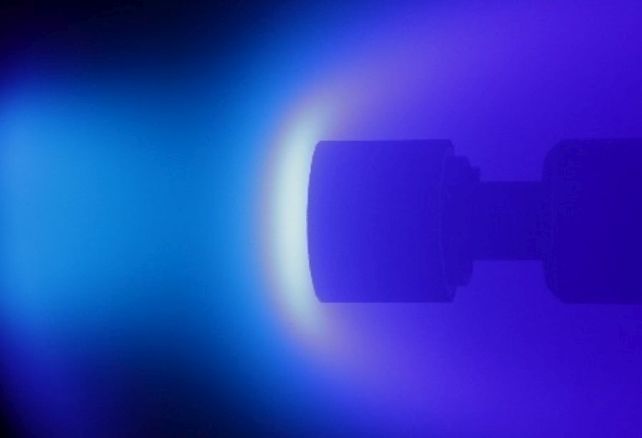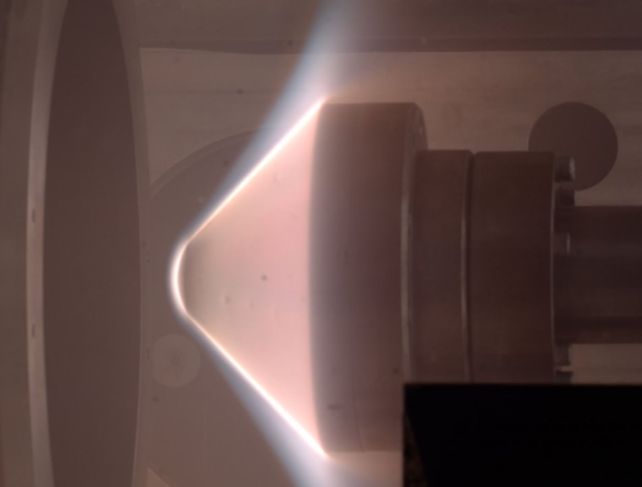Key Takeaways:
- Scientists simulated atmospheric conditions of Uranus and Neptune to prepare for potential missions.
- Uranus and Neptune remain largely unexplored; Voyager 2 provided limited data in the 1980s.
- Designing probes for these ice giants requires systems that can withstand extreme pressures and temperatures.
- High-speed atmospheric entry of probes demands protection against intense heat fluxes.
- Experimental successes in plasma tunnels offer insights for developing sensors to explore Uranus and Neptune’s atmospheres.
The mysteries lurking within Uranus and Neptune, our Solar System’s enigmatic ice giants, have long fascinated scientists. With these distant planets remaining relatively uncharted territories compared to their celestial neighbors, a team of international researchers embarked on a groundbreaking mission to simulate the uncharted realms and unravel the complexities of these icy giants.

Conducted through innovative high-temperature plasma tunnels, this endeavor aimed to envision the potential scenarios of plunging into the depths of Uranus and Neptune, offering critical insights into designing probes capable of enduring the extreme rigors inherent to these distant planets’ atmospheres.
Louis Walpot, an aerothermodynamics engineer at the European Space Agency (ESA), highlighted the primary challenge faced in designing probes for such missions. “Any probe would be subjected to high pressures and temperatures, necessitating a high-performance thermal protection system to withstand the atmospheric entry for a useful duration,” explained Walpot. This necessity prompted scientists to replicate atmospheric conditions akin to those on Uranus and Neptune, a vital step preceding potential missions to these distant ice giants.

Despite extensive exploration missions within our Solar System, Uranus and Neptune have remained elusive, receiving only fleeting attention during Voyager 2’s brief flyby in the 1980s. This limited encounter has left gaping knowledge voids about these intriguing outer planets, spurring NASA and ESA scientists to intensify efforts to send dedicated missions to bridge these gaps.

While these ice giants share similarities, such as their icy composition, intriguing distinctions emerge, including differences in their atmospheric hues caused by gas distribution. Understanding these disparities is crucial, especially given the significant variations between their atmospheres and those of gas giants like Saturn and Jupiter, rendering comparisons inadequate for deciphering the unique dynamics at play on Uranus and Neptune.
A primary objective for scientists involves deploying atmospheric probes akin to NASA’s Galileo mission’s entry probe to Jupiter. However, these probes must withstand the extreme conditions encountered during entry and transmission of data back to Earth, requiring meticulous preparation and robust engineering.
To replicate the conditions, an international team devised a subscale entry probe akin to Galileo’s and utilized cutting-edge facilities at Oxford University in the UK and the University of Stuttgart in Germany. These facilities, such as the T6 Stalker Tunnel and plasma wind tunnels, allowed for the creation of atmospheric analogs using gas mixtures resembling those found on Uranus and Neptune.
Through these experiments, researchers successfully measured convective heat flux on the probe’s surface, critical for comprehending the challenges posed by high-speed entries into the ice giants’ atmospheres.
Walpot elaborated on the capabilities of the T6 Stalker Tunnel, noting its adaptability to various testing modes, enabling exploration from subscale modeling to fundamental high-speed flow processes.

Simultaneously, the plasma tunnel at the University of Stuttgart stands as the sole facility worldwide capable of studying ablation and pyrolysis effects on spacecraft shielding, further enriching the understanding gleaned from these simulations.
The triumphant execution of these experiments marks a significant milestone, furnishing scientists with pivotal data to refine sensor development crucial for exploring the enigmatic depths of Uranus and Neptune’s atmospheres.
As the quest to unlock the secrets of these ice giants continues, these simulated scenarios stand as guiding beacons illuminating the path toward future missions into the uncharted realms of our celestial neighborhood.


